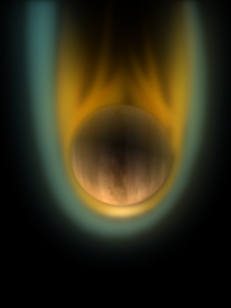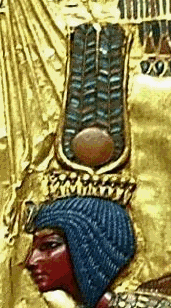|
|
|
 
Left: Diagram and
Animation of the solar wind
interacting with the atmosphere of
Venus. Credit: ESA/C. Carreau.
Right: Close up of Ankhsunamun’s
'comet’ crown on the back of
Tutankhamun’s throne.
Velikovsky's Comet Venus
Mar
12, 2010
Immanuel Velikovsky concluded
from his extensive interdisciplinary
research that the planet Venus was
remembered from the time of the dawn
of civilization as a brilliant
cometary body.
While there is a
wealth of literary sources to draw
upon, when it comes to the pictorial
evidence it isn’t as forthcoming. No
images can be conclusively
identified as actually representing
Venus in cometary form, a situation
that essentially shouldn’t exist.
After all, it stands to reason that
it was naked eye observations that
primarily inspired the myths. So, at
the very least the imagery should be
equal to or analogous to the
literary sources – but this clearly
isn’t the case.
Have we overlooked something? Is it
possible images of Comet Venus have
been staring us in the face for
decades?
The image on the right has been
taken from the back of Tutankhamun’s
throne. It depicts the wife of king
Tut, Ankhsunamun. The queen is shown
wearing a very distinctive crown
consisting of a disk surmounted by
cow horns and two tall plumes.
This unusual headdress made its
appearance in the New Kingdom and
features prominently in Egyptian art
- numerous queens can be seen
sporting this particular crown.
Although the actual shape or outline
remained constant (for approximately
900 years), there exist a few
variants to the colours shown. For
example, the disk was predominantly
painted the traditional Egyptian
deep red, the ‘horns’ normally
black, while the plumes can be gold,
a plain yellow, or blue and without
the ‘filaments‘.
Like most Egyptian crowns
encompassing a sphere, it somehow
represents an aspect of the sun, or
so the conventional way of thinking
goes. This is a perplexing line of
thought since the Sun is a golden
glaring ball—it doesn’t have cow
horns wrapped around it and most
certainly exhibits no signs of
enormous cometary tails.
It is apparent even to the
uninitiated that what we are looking
at here is a comet—a large comet
with a plumed tail. Furthermore, if
Egyptian art is used as a measure of
time, this comet graced our skies
for nearly a thousand years. It is
carved, painted, and represented in
statues the length and breadth of
the Nile valley. Even the legendary
Cleopatra wore this headdress.
Could this particular crown be a
true-life physical representation of
proto-Venus as it appeared in
ancient times?
To quote Wal Thornhill:
'In the electrical model of the
solar system, any body on a
sufficiently eccentric orbit about
the Sun will exhibit cometary
features. For ancient people to have
seen Venus as an Earth-threatening
comet, Venus must have had an
eccentric orbit that brought the
planet near to Earth'.
Are we looking at Velikovsky’s comet
Venus?
Comparing the comet crown with the
Venus diagram on the left reveals
some fundamental similarities, far
too close to be deemed coincidental.
In fact, for all intents and
purposes they are virtually
identical!
The orb represents the body of
Venus: the horns signify the bow
shock as the solar wind slams into
the Venusian surface, enveloping its
body due to a lack of an intrinsic
magnetic field. The two large plumes
represent Venus’ magnetotail—split
in two and flowing downstream at
least three times its diameter.
The image on the left is just a
diagram, and today Venus’ comet tail
can only be detected by
magnetometers and charged particle
detectors. However, place Venus on
an eccentric orbit in a highly
charged ‘dusty’ environment and the
normally invisible magnetotail (and
bow shock) would become highly
visible.
Wal Thornhill commenting on Venus’
cometary magnetotail:
'A power surge in those filaments
today would cause them to glow, and
Venus would form a "stupendous"
cometary apparition in the sky. The
forensic evidence would stand up in
court, showing that Venus was a
comet within human memory'.
Science is slowly proving Velikovsky
to be correct in a number of areas.
Perhaps with the comet crown of
ancient Egypt we now have the
pictorial evidence to match.
Contributed by Gary Gilligan
http://gks.uk.com/
|
|
|
|
|
|
|
|
|
YouTube video, first glimpses of Episode Two in the "Symbols of an Alien Sky"
series.
|
|
|
|
|
|
|
Three ebooks in the Universe Electric series are
now available. Consistently
praised for easily understandable text and exquisite graphics.
|
|
|
|
|
|
|
|
|
|








